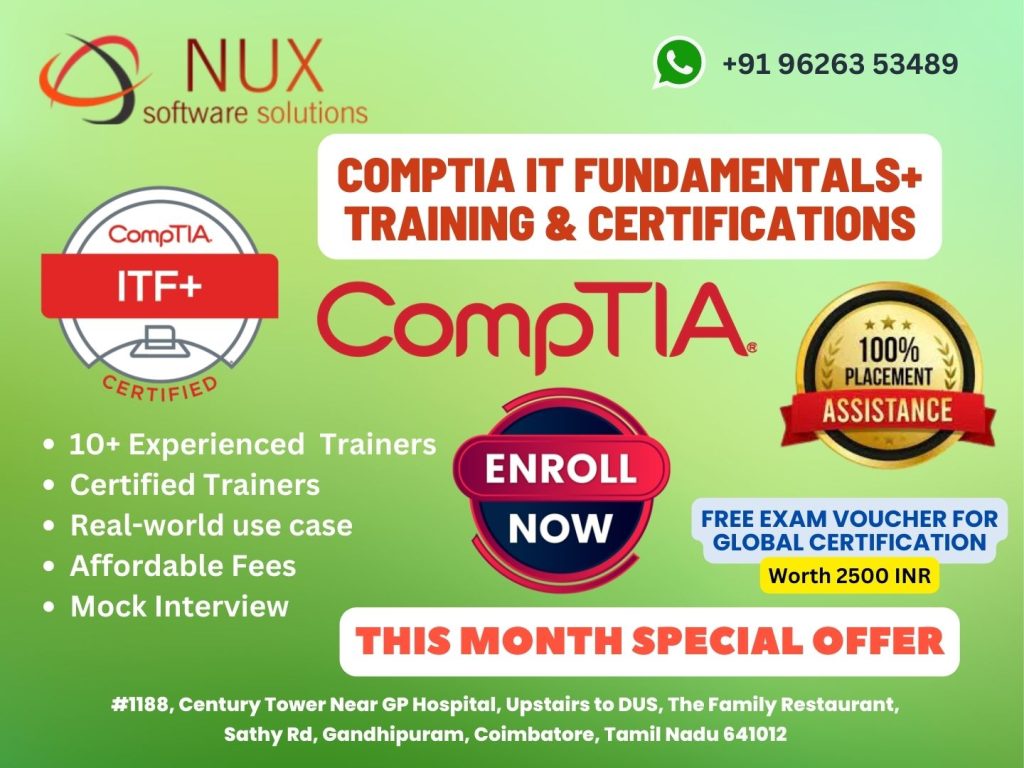Top CompTIA Linux+ Training and Certification Institute in Coimbatore

Course Overview
The CompTIA Linux+ certification is a globally respected credential that validates the essential skills required to manage, troubleshoot, and secure Linux operating systems. It is the only Linux certification that covers foundational skills demanded across IT roles, making it ideal for anyone pursuing a career in system administration, cybersecurity, DevOps, or cloud computing.
Unlike other certifications, Linux+ focuses on the practical, hands-on tasks Linux administrators perform daily, such as configuration, command-line interface operations, scripting basics, permissions, security, networking, storage, containers, and automation.
This course is perfect for IT professionals who want to expand their skill set into the world of open-source systems and enterprise Linux environments. Our training in Coimbatore is designed to equip you with the knowledge needed to confidently pass the CompTIA Linux+ XK0-005 exam and succeed in real-world Linux system administration roles.
Who Should Take This Course?
System Administrators
Linux Support Technicians
Cloud Administrators
DevOps Engineers
Network Engineers working in hybrid environments
Key Course Features
Comprehensive training aligned with CompTIA Linux+ exam objectives
Real-world lab exercises with Ubuntu, CentOS, and Red Hat distributions
Instructor-led sessions by certified Linux professionals
Practical focus on automation, shell scripting, system security, and services
Exam preparation support with mock tests and revision sessions
Career Opportunities After Certification
Junior Linux Administrator
IT Support Specialist (Linux)
DevOps Support Engineer
Cloud Support Technician
Security Analyst (Linux environments)
Why Choose Us?
Practical, hands-on learning environment with real Linux servers
Career-focused training with real-world Linux use cases
Flexible scheduling options – online, offline, and weekend classes
Certification support from start to finish
A valuable stepping stone to RHCSA, RHCE, or Linux-based cloud certifications
Master Linux system administration and open up career opportunities in cloud computing, cybersecurity, and DevOps with the CompTIA Linux+ certification.
CompTIA Linux+ LX0-104 Syllabus
Modules
Customize or write simple scripts.
SQL data management.
User Interfaces and Desktops Install and configure X11.
Set up a display manager.
Accessibility.
Manage user and group accounts and related system files.
Automate system administration tasks by scheduling jobs.
Localization and internationalization.
Essential System Services System logging.
Mail Transfer Agent (MTA) basics.
Manage printers and printing.
Networking Fundamentals Fundamentals of Internet protocols.
Basic network configuration.
Basic network troubleshooting.
Configure client side DNS.
Security Perform security administration tasks.
Set up host security.
Securing data with encryption.
Shells, Scripting and Data Management 17%
1. Set environment variables (e.g., PATH) at login or when spawning a new shell,
2. Write BASH functions for frequently used sequences of commands,
3. Maintain skeleton directories for new user accounts,
4. Set command search path with the proper directory,
5. The following is a partial list of the used files, terms and utilities:
Source
/etc/bash.bashrc
/etc/profile
env
export
set
unset
~/.bash_profile
~/.bash_login
~/.profile
~/.bashrc
~/.bash_logout
function
alias
lists
1. Use standard sh syntax (loops, tests),
2. Use command substitution,
3. Test return values for success or failure or other information provided by a command,
4. Perform conditional mailing to the superuser,
5. Correctly select the script interpreter through the shebang (#!) line,
6. Manage the location, ownership, execution and SUID rights of scripts,
7. The following is a partial list of the used files, terms and utilities,
for
while
test
if
read
seq
exec
1. Use of basic SQL commands,
2. Perform basic data manipulation,
3. The following is a partial list of the used files, terms and utilities:
insert
update
select
delete
from
where
group by
order by
join
User Interfaces and Desktops 8%
1. Verify that the video card and monitor are supported by an X server
2. Awareness of the X font server
3. Basic understanding and knowledge of the X Window configuration file
4. The following is a partial list of the used files, terms and utilities:
/etc/X11/xorg.conf
xhost
DISPLAY
xwininfo
xdpyinfo
X
1. Basic configuration of LightDM
2. Turn the display manager on or off
3. Change the display manager greeting
4. Awareness of XDM, KDM and GDM
5. The following is a partial list of the used files, terms and utilities:
lightdm
/etc/lightdm/
1. Basic knowledge of keyboard accessibility settings (AccessX)
2. Basic knowledge of visual settings and themes
3. Basic knowledge of assistive technology (AT)
4. The following is a partial list of the used files, terms and utilities:
Sticky/repeat keys
Slow/bounce/toggle keys
Mouse keys
High contrast/large print desktop themes
Screen reader
Braille display
Screen magnifier
On-screen keyboard
Gestures (used at login, for example gdm)
Orca
GOK
Emacspeak
Administrative Tasks 20%
1. Add, modify and remove users and groups
2. Manage user/group info in password/group databases
3. Create and manage special purpose and limited accounts
4. The following is a partial list of the used files, terms and utilities:
/etc/passwd
/etc/shadow
/etc/group
/etc/skel
chage
getent
groupadd
groupdel
groupmod
passwd
useradd
userdel
usermod
1. Manage cron and at jobs
2. onfigure user access to cron and at services
3. Configure anacron
4. The following is a partial list of the used files, terms and utilities:
/etc/cron. {d,daily,hourly,monthly,weekly}
/etc/at.deny
/etc/at.allow
/etc/crontab
/etc/cron.allow
/etc/cron.deny
/var/spool/cron/*
crontab
at
atq
atrm
anacron
/etc/anacrontab
1. Configure local settings and environment variables
2. Configure timezone settings and environment variables
3. The following is a partial list of the used files, terms and utilities:
/etc/timezone
/etc/localtime
/usr/share/zoneinfo
Environment variables:
LC_*
LC_ALL
LANG
TZ
/usr/bin/locale
tzselect
tzconfig
date
iconv
UTF-8
ISO-8859
ASCII
Unicode
Essential System Services 17%
1. Set the system date and time
2. Set the hardware clock to the correct time in UTC
3. Configure the correct timezone
4. Basic NTP configuration
5. Knowledge of using the pool.ntp.org service
6. Awareness of the ntpq command
7. The following is a partial list of the used files, terms and utilities:
/usr/share/zoneinfo
/etc/timezone
/etc/localtime
/etc/ntp.conf
date
hwclock
ntpd
ntpdate
pool.ntp.org
1. Configuration of the syslog daemon
2. Understanding of standard facilities, priorities and actions
3. Configuration of logrotate
4. Awareness of rsyslog and syslog-ng
5. The following is a partial list of the used files, terms and utilities:
syslog.conf
syslogd
klogd
/var/log/
logger
logrotate
/etc/logrotate.conf
/etc/logrotate.d/
Journalctl
/etc/systemd/journald.conf
/var/log/journal/
1. Create email aliases
2. Configure email forwarding
3. Knowledge of commonly available MTA programs (postfix, sendmail, qmail, exim) (no configuration)
4. The following is a partial list of the used files, terms and utilities:
~/.forward
sendmail emulation layer commands
newaliases
mail
mailq
postfix
sendmail
exim
qmail
1. Basic CUPS configuration (for local and remote printers)
2. Manage user print queues
3. Troubleshoot general printing problems
4. Add and remove jobs from configured printer queues
5. The following is a partial list of the used files, terms and utilities:
CUPS configuration files, tools and utilities
/etc/cups
lpd legacy interface (lpr, lprm, lpq)
Networking Fundamentals 23%
1. Demonstrate an understanding of network masks and CIDR notation
2. Knowledge of the differences between private and public “dotted quad” IP addresses
3. Knowledge about common TCP and UDP ports (20, 21, 22, 23, 25, 53, 80, 110, 123, 139, 143, 161, 162, 389,
443, 465, 514, 636, 993, 995)
4. Knowledge about the differences and major features of UDP, TCP and ICMP
5. Knowledge of the major differences between IPv4 and IPv6
6. Knowledge of the basic features of IPv6
7. The following is a partial list of the used files, terms and utilities:
/etc/services
IPv4, IPv6
Subnetting
TCP, UDP, ICMP
1. Manually and automatically configure network interfaces
2. Basic TCP/IP host configuration
3. Setting a default route
4. The following is a partial list of the used files, terms and utilities:
/etc/hostname
/etc/hosts
/etc/nsswitch.conf
ifconfig
ifup
ifdown
ip
route
ping
1. Manually and automatically configure network interfaces and routing tables to include adding, starting,
stopping, restarting, deleting or reconfiguring network interfaces
2. Change, view or configure the routing table and correct an improperly set default route manually
3. Debug problems associated with the network configuration
4. The following is a partial list of the used files, terms and utilities:
ifconfig
ip
ifup
ifdown
route
host
hostname
dig
netstat
ping
ping6
traceroute
traceroute6
tracepath
tracepath6
netcat
1. Query remote DNS servers
2. Configure local name resolution and use remote DNS servers
3. Modify the order in which name resolution is done
4. The following is a partial list of the used files, terms and utilities:
/etc/hosts
/etc/resolv.conf
/etc/nsswitch.conf
Host
Dig
getent
Security 15%
1. Audit a system to find files with the suid/sgid bit set
2. Set or change user passwords and password aging information
3. Being able to use nmap and netstat to discover open ports on a system
4. Set up limits on user logins, processes and memory usage
5. Determine which users have logged in to the system or are currently logged in
6. Basic sudo configuration and usage
7. The following is a partial list of the used files, terms and utilities:
find
passwd
fuser
lsof
nmap
chage
netstat
sudo
/etc/sudoers
su
usermod
ulimit
who, w, last
1. Awareness of shadow passwords and how they work
2. Turn off network services not in use
3. Understand the role of TCP wrappers
4. The following is a partial list of the used files, terms and utilities:
/etc/nologin
/etc/passwd
/etc/shadow
/etc/xinetd.d/*
/etc/xinetd.conf
/etc/inetd.d/*
/etc/inetd.conf
/etc/inittab
/etc/init.d/*
/etc/hosts.allow
/etc/hosts.deny
1. Perform basic OpenSSH 2 client configuration and usage
2. Understand the role of OpenSSH 2 server host keys
3. Perform basic GnuPG configuration, usage and revocation
4. Understand SSH port tunnels (including X11 tunnels)
5. The following is a partial list of the used files, terms and utilities:
ssh
ssh-keygen
ssh-agent
ssh-add
~/.ssh/id_rsa and id_rsa.pub
~/.ssh/id_dsa and id_dsa.pub
/etc/ssh/ssh_host_rsa_key and ssh_host_rsa_key.pub
/etc/ssh/ssh_host_dsa_key and ssh_host_dsa_key.pub
~/.ssh/authorized_keys
/etc/ssh_known_hosts
gpg
~/.gnupg/*



